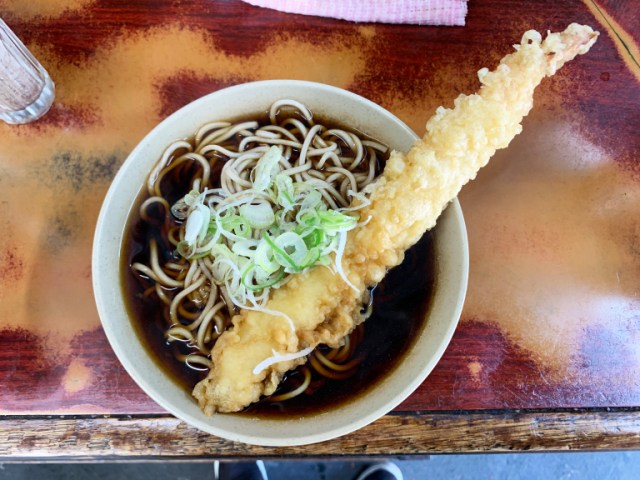
Not far from Akihabara, there’s a soba spot that gave us food to eat and food for thought.
A lot of restaurants in Japan don’t want to waste space on their signs writing their name, because they’d rather focus on communicating what kind of food they offer. For example, on a recent walk through Tokyo’s Higashi Kanda neighborhood, not far from Akihabara, we spotted this yellow sign.
The そば part reads “soba,” letting us know that the restaurant serves up buckwheat noodles. The 立食 part, tachigui, isn’t the place’s name either, just a term used to describe “stand and eat” restaurants where you wat at a counter with no chair.
But hey, that was all the sign needed to pique the interest of our Japanese-language reporter Seiji Nakazawa. Seiji loves soba, and he loves the ultra-affordable prices of tachigui joints, so decided to check the place out.
Still, he couldn’t help but feel a little curious about what the name of the place is, so as walked up to the building he scanned the walls, windows, and awning.
There were no hints, though. Even the noren, the cloth drapery hanging in front of the entrance, just said “soba udon,” informing him that diners can choose between those two kinds of noodles.
So he walked around to the other side of the restaurant…
…but again, all he saw were names of food: “Soba.” “Udon.” “Tendon (tempura rice bowls).” “Curry.” Not so much as a single clue as to what the name of the restaurant is.
Realizing there was no other way to satisfy both the hunger in his belly and the curiosity in his mind, Seiji stepped inside and asked the man behind the counter, Maeda, who turned out to be the restaurant’s owner.
“Excuse me, what’s the name of this restaurant?” Seiji said, to which the man promptly answered “Soba Sen.”
Ah ha! So it does have a name. But then…why isn’t it written anywhere?
Maeda explained:
“This restaurant has been in business here for about 50 years, but in the beginning it didn’t have any set name. People just called it ‘the yellow sign soba place’ or ‘Ito,’ the name of the previous owner. I’m just carrying on that tradition of not writing the restaurant’s name on our sign.”
But while his appreciation for tradition gives Soba Sen a connection to its past, Maeda isn’t a completely old-school guy. He worked in IT until about five years ago, and even now enjoys building PCs as a hobby.
▼ By this point in their conversation, Seiji’s 410-yen (US$3.95) soba, with its jumbo tempura shrimp, was ready.
So how did Maeda got from the world of high technology to the one of soba noodles?
“My mom worked here for 20 years, starting out as a part-timer and working her way up until she took over as owner from the person who hired her. About five years ago, though, she was looking to retire, and there wasn’t anyone to take over from her. So I agreed to help out in the restaurant for a couple of months, and before I realized it I’d been here for so long that I ended up becoming the owner.”
Soba Sen’s noodles, with their flavorful broth, are fortifying and tasty, and felt even more so as Seiji reflected on how they’re made by someone who hadn’t even really planned on becoming a soba pro in the first place.
“You never know where life is going to take you,” thought Seiji as he slurped his soba. Sometimes not knowing what your next adventure is going to be makes it all the more special, though, just like going into a restaurant you don’t know the name of gives the food, and the experience, its own special flavor.
Restaurant information
Soba Sen / そば千
Address: Tokyo-to, Chiyoda-ku, Higashi Kanda 1-17-4
東京都千代田区東神田1-17-4
Open 3 p.m.-7 p.m.
Closed Saturdays, Sundays, Holidays
Photos ©SoraNews24
● Want to hear about SoraNews24’s latest articles as soon as they’re published? Follow us on Facebook and Twitter!
[ Read in Japanese ]


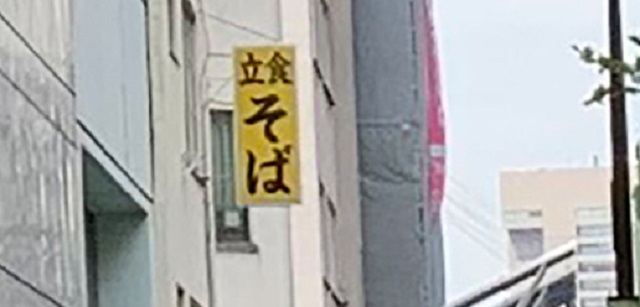
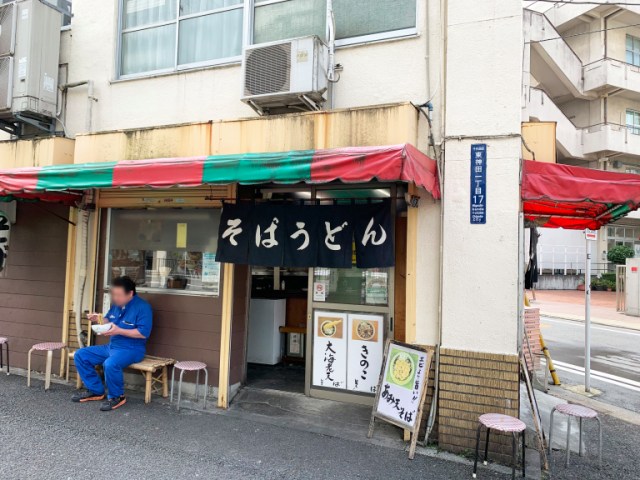
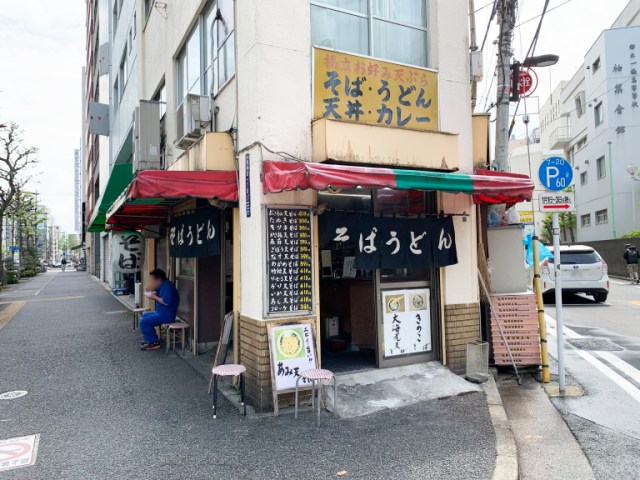
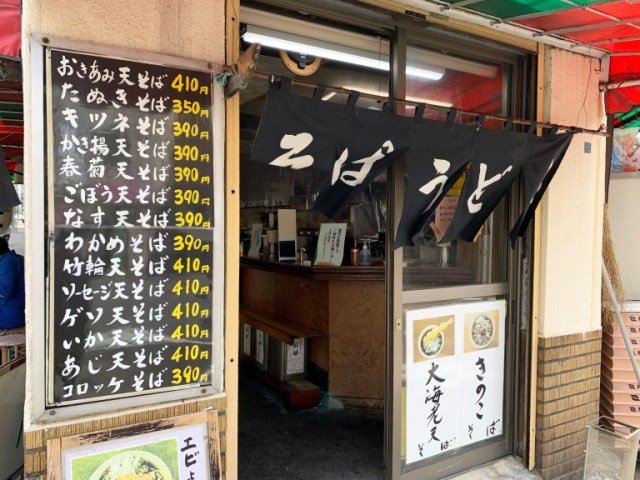
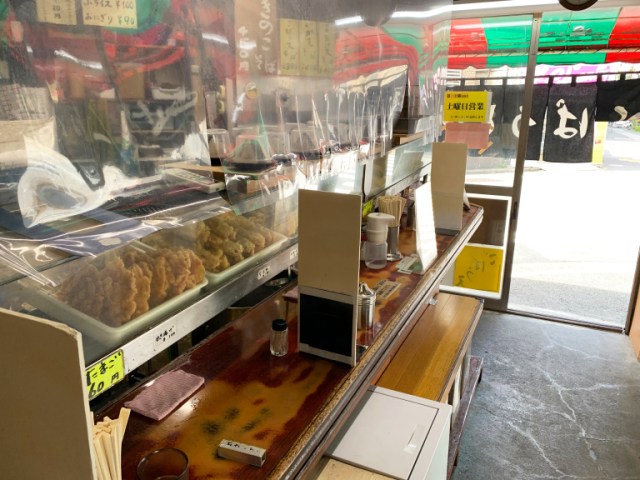
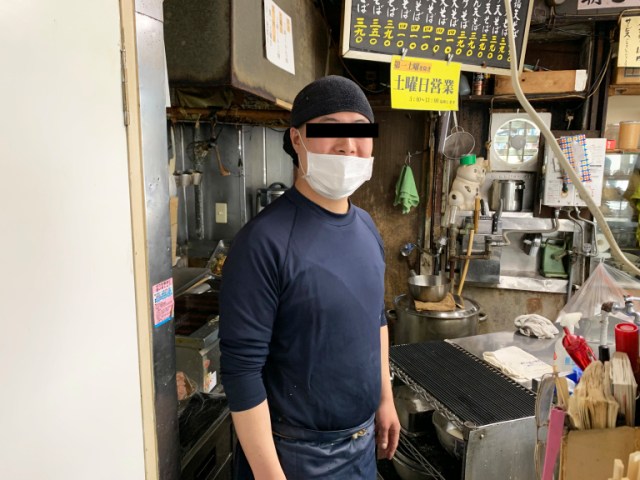
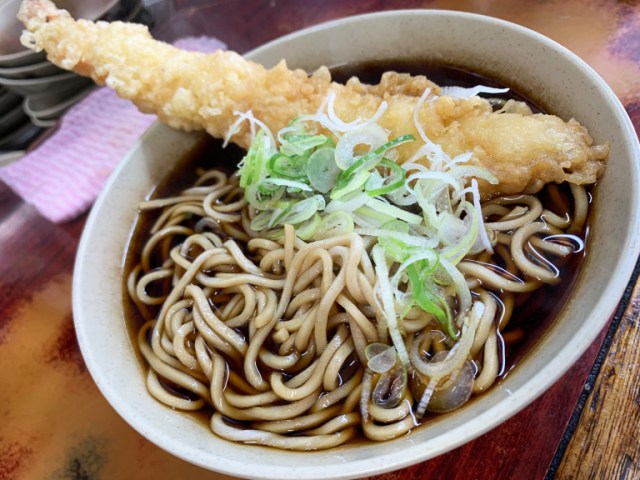
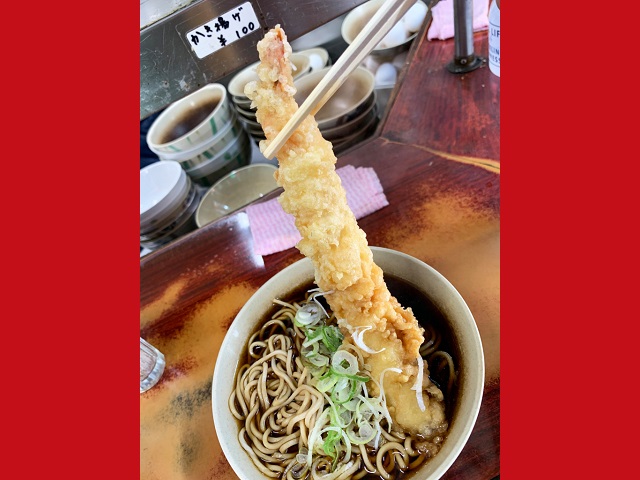
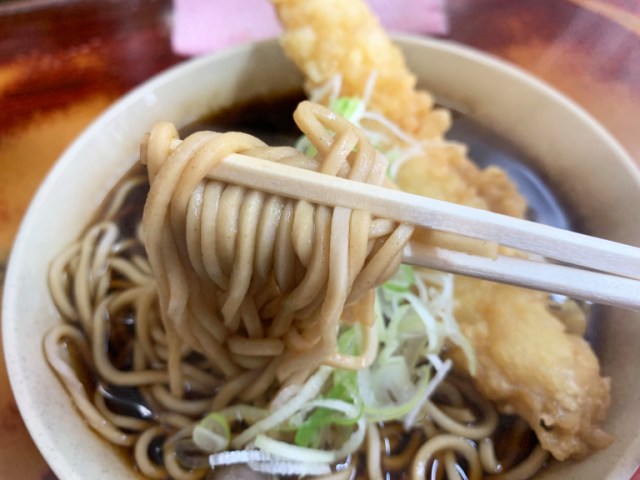
 Saga Prefecture’s hidden gem of a soba restaurant offers scrumptious, full course soba meals
Saga Prefecture’s hidden gem of a soba restaurant offers scrumptious, full course soba meals Shibuya City Office serves up insanely cheap soba noodles, but are they any good?
Shibuya City Office serves up insanely cheap soba noodles, but are they any good? New famous food of Akihabara! Reiwa garlic chive ramen is delicious two times per meal
New famous food of Akihabara! Reiwa garlic chive ramen is delicious two times per meal Why did this stand-and-eat soba noodle shop in Tokyo open in the middle of the pandemic?
Why did this stand-and-eat soba noodle shop in Tokyo open in the middle of the pandemic? “Hey, Japanese taxi driver, take us to the best Yaeyama soba noodles on Ishigaki Island!”
“Hey, Japanese taxi driver, take us to the best Yaeyama soba noodles on Ishigaki Island!” Foreigner’s request for help in Tokyo makes us sad for the state of society
Foreigner’s request for help in Tokyo makes us sad for the state of society Seaside scenery, history, and so many desserts on Yokohama’s Akai Kutsu【Japan Loop Buses】
Seaside scenery, history, and so many desserts on Yokohama’s Akai Kutsu【Japan Loop Buses】 Japanese city loses residents’ personal data, which was on paper being transported on a windy day
Japanese city loses residents’ personal data, which was on paper being transported on a windy day Should you add tartar sauce to Japanese curry rice? CoCo Ichi makes diners an unusual offer
Should you add tartar sauce to Japanese curry rice? CoCo Ichi makes diners an unusual offer Harajuku Station’s beautiful old wooden building is set to return, with a new complex around it
Harajuku Station’s beautiful old wooden building is set to return, with a new complex around it Akihabara pop-up shop sells goods made by Japanese prison inmates
Akihabara pop-up shop sells goods made by Japanese prison inmates Red light district sushi restaurant in Tokyo shows us just how wrong we were about it
Red light district sushi restaurant in Tokyo shows us just how wrong we were about it French Fries Bread in Tokyo’s Shibuya becomes a hit on social media
French Fries Bread in Tokyo’s Shibuya becomes a hit on social media Ghibli Park now selling “Grilled Frogs” from food cart in Valley of Witches
Ghibli Park now selling “Grilled Frogs” from food cart in Valley of Witches McDonald’s Japan releases a pancake pie for new retro kissaten coffeeshop series
McDonald’s Japan releases a pancake pie for new retro kissaten coffeeshop series McDonald’s new Happy Meals offer up cute and practical Sanrio lifestyle goods
McDonald’s new Happy Meals offer up cute and practical Sanrio lifestyle goods Japanese ramen restaurants under pressure from new yen banknotes
Japanese ramen restaurants under pressure from new yen banknotes Studio Ghibli releases new action figures featuring Nausicaä of the Valley of the Wind characters
Studio Ghibli releases new action figures featuring Nausicaä of the Valley of the Wind characters New private rooms on Tokaido Shinkansen change the way we travel from Tokyo to Kyoto
New private rooms on Tokaido Shinkansen change the way we travel from Tokyo to Kyoto Tokyo Tsukiji fish market site to be redeveloped with 50,000-seat stadium, hotel, shopping center
Tokyo Tsukiji fish market site to be redeveloped with 50,000-seat stadium, hotel, shopping center All-you-can-drink Starbucks and amazing views part of Tokyo’s new 170 meter-high sky lounge
All-you-can-drink Starbucks and amazing views part of Tokyo’s new 170 meter-high sky lounge Beautiful Ghibli sealing wax kits let you create accessories and elegant letter decorations【Pics】
Beautiful Ghibli sealing wax kits let you create accessories and elegant letter decorations【Pics】 Studio Ghibli releases Kiki’s Delivery Service chocolate cake pouches in Japan
Studio Ghibli releases Kiki’s Delivery Service chocolate cake pouches in Japan New definition of “Japanese whiskey” goes into effect to prevent fakes from fooling overseas buyers
New definition of “Japanese whiskey” goes into effect to prevent fakes from fooling overseas buyers Our Japanese reporter visits Costco in the U.S., finds super American and very Japanese things
Our Japanese reporter visits Costco in the U.S., finds super American and very Japanese things Studio Ghibli unveils Mother’s Day gift set that captures the love in My Neighbour Totoro
Studio Ghibli unveils Mother’s Day gift set that captures the love in My Neighbour Totoro More foreign tourists than ever before in history visited Japan last month
More foreign tourists than ever before in history visited Japan last month New Pokémon cakes let you eat your way through Pikachu and all the Eevee evolutions
New Pokémon cakes let you eat your way through Pikachu and all the Eevee evolutions Sales of Japan’s most convenient train ticket/shopping payment cards suspended indefinitely
Sales of Japan’s most convenient train ticket/shopping payment cards suspended indefinitely Sold-out Studio Ghibli desktop humidifiers are back so Totoro can help you through the dry season
Sold-out Studio Ghibli desktop humidifiers are back so Totoro can help you through the dry season Japanese government to make first change to romanization spelling rules since the 1950s
Japanese government to make first change to romanization spelling rules since the 1950s Ghibli founders Toshio Suzuki and Hayao Miyazaki contribute to Japanese whisky Totoro label design
Ghibli founders Toshio Suzuki and Hayao Miyazaki contribute to Japanese whisky Totoro label design Doraemon found buried at sea as scene from 1993 anime becomes real life【Photos】
Doraemon found buried at sea as scene from 1993 anime becomes real life【Photos】 Tokyo’s most famous Starbucks is closed
Tokyo’s most famous Starbucks is closed One Piece characters’ nationalities revealed, but fans have mixed opinions
One Piece characters’ nationalities revealed, but fans have mixed opinions We asked a Uniqlo employee what four things we should buy and their suggestions didn’t disappoint
We asked a Uniqlo employee what four things we should buy and their suggestions didn’t disappoint Princesses, fruits, and blacksmiths: Study reveals the 30 most unusual family names in Japan
Princesses, fruits, and blacksmiths: Study reveals the 30 most unusual family names in Japan Robot-operated soba stand in Tokyo is too busy for its machine chef to keep up with
Robot-operated soba stand in Tokyo is too busy for its machine chef to keep up with What the heck is okame soba?
What the heck is okame soba? The best soba restaurant on Yakushima island, according to locals
The best soba restaurant on Yakushima island, according to locals We try cooking yakisoba with real Japanese buckwheat soba【SoraKitchen】
We try cooking yakisoba with real Japanese buckwheat soba【SoraKitchen】 What does a family restaurant in the middle of nowhere, Hokkaido, serve? We find out
What does a family restaurant in the middle of nowhere, Hokkaido, serve? We find out This is the one and only kakuni pork bowl restaurant in Tokyo, and it’s amazing
This is the one and only kakuni pork bowl restaurant in Tokyo, and it’s amazing Tokyo Secret Eats: Shibuya City staff cafeteria serves Hachiko soba to visitors
Tokyo Secret Eats: Shibuya City staff cafeteria serves Hachiko soba to visitors Tom Hanks visits Japan, blends in with oyaji at restaurant in Tokyo
Tom Hanks visits Japan, blends in with oyaji at restaurant in Tokyo Marvelous Soba: Colour-changing noodle broth creates a twist ending to your meal
Marvelous Soba: Colour-changing noodle broth creates a twist ending to your meal What’s so funny about “Sweet Fries of Clowns” from Burger King Japan?
What’s so funny about “Sweet Fries of Clowns” from Burger King Japan? We encountered the most frightening fried chicken in Ameyokocho in Tokyo, and ate it anyway
We encountered the most frightening fried chicken in Ameyokocho in Tokyo, and ate it anyway How to turn a classic Japanese noodle dish into Studio Ghibli’s Totoro
How to turn a classic Japanese noodle dish into Studio Ghibli’s Totoro Kakiage towers and Italian soba? We try out a unique soba restaurant in Tokyo
Kakiage towers and Italian soba? We try out a unique soba restaurant in Tokyo Pitch-black Black Belt udon noodles are a visual roundhouse, but do they taste good?【Taste test】
Pitch-black Black Belt udon noodles are a visual roundhouse, but do they taste good?【Taste test】 Check if you have a soba allergy with these amazing ukiyoe-print temporary tattoos!
Check if you have a soba allergy with these amazing ukiyoe-print temporary tattoos!
Leave a Reply